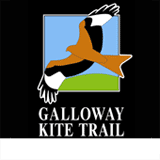2. Nesting & Breeding
 Click for more images Click for more images | |
Nesting & BreedingNest:- Dead twigs and lined with grass and other vegetation. A quantity of sheeps wool is often added 2-3 days prior to egg laying. Kites will include plastic bags, litter, paper, small clothing items and even discards such as fluffy toys, small flags, strings or bunting.Brood:- Once per annum ( March - May), female will re-lay after a loss of eggs, but not after loss of young.  Eggs:- 1 - 4 (occasionally 5) white with red-brown spots, laid at 3 day intervals. Incubation:- 31-32 days (38 days for clutch of 3 eggs). Young: -helpless when at downy stage. Fledging:- 48-70 days. The red kite is a monogamous breeder. In migrant populations the pair bond is probably seasonal, but is renewed every year with the same individuals largely due to individuals' attachment to specific home range and eyrie. In resident populations the pair-bond is retained loosely throughout the winter, especially where the breeding home range is still occupied. Each nesting territory contains 1-5 alternative nest sites. The nest is built by both birds on a main fork high in a tree, 12-20m above ground. It is constructed of dead twigs and lined with grass and other vegetation. A quantity of sheeps wool is often added 2-3 days prior to egg laying. New material is added to the nest throughout the breeding season, and a nest that has been in use for a number of seasons grows to a considerable size. If nesting is successful, the same nest is used the following year. At times even old buzzard or raven nests are used. The clutch of white eggs, with red-brown spots, are laid at 3 day intervals in April. The incubation is by the female alone for 31 to 38 days (see above). Incubation starts with the first egg, and as such hatching is spread over several days. The male provides the female food during incubation. She rarely leaves the eggs unattended for more than a few minutes at a time. The female cares for the young with the male provisioning all food for his mate and young for the first two weeks after hatching. After this the female will share hunting, and the young are able to feed themselves from food placed in the nest. From one week of age aggression between siblings becomes apparent, but this is rarely the direct cause of the death of the younger ones. The fledging period is variable, depending on the size of the brood and food availability. The young may start to clamber about the nest tree by 45 days, but rarely fledge before 48-50 days, sometimes not until 60-70 days. Parents care for them in the vicinity of the nest for a further 15-20 days. The young birds will breed for the first time when they are two years old. Only one brood is raised in a year. The female will re-lay after a loss of eggs, but not after loss of young. | |
 |
|
|









